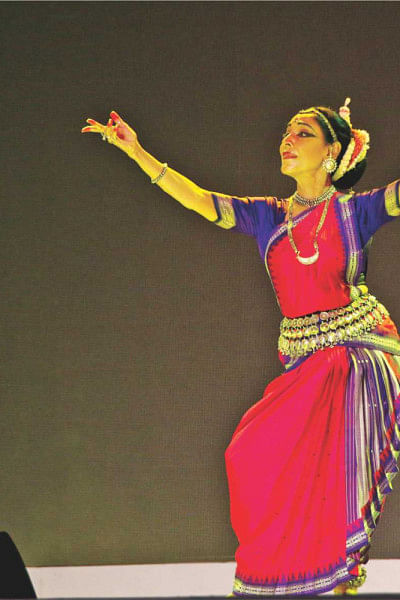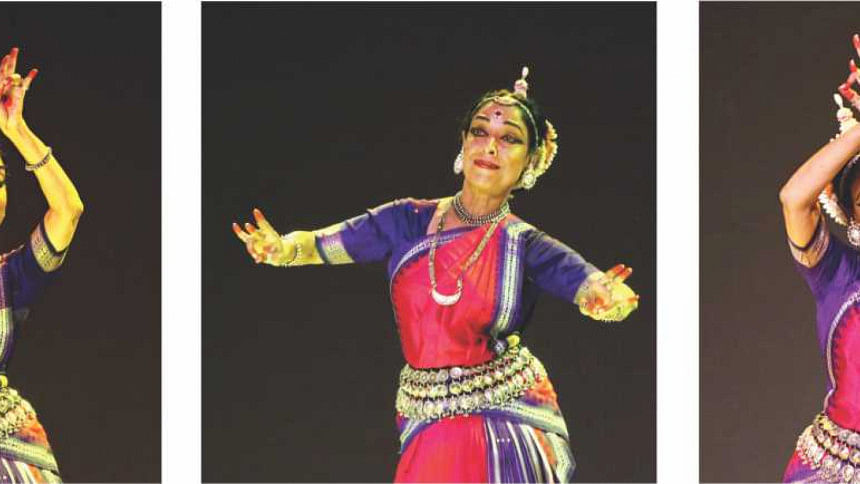“Dance itself is a universal language…”

Photos: Sheikh Mehedi Morshed
Madhavi Mudgal is a renowned dancer, choreographer, and teacher who has been contributing to the progression of classical Odissi dance with her aesthetic vision and talent. She has become India's prime Odissi exponent, winning awards, acclaim and hearts alike, for sustaining the art form's authenticity while pushing it beyond traditional limitations. Born into a family deeply related to advocating the classical arts, she was involved in music and dance from a very young age. She has trained under Guru Hare Krishna Bahera and Guru Kelucharan Mahapatra. Through teaching, performing and conducting workshops, Madhavi has been actively involved in propagating the art of Odissi for the youth of today. In 2016’s edition, she first performed for the Bengal Classical Music Festival (BCMF) where she and her student/niece, Arushi Mudgal, enthralled the Bangladeshi audience with the beauty and grace of Odissi dance. She spoke to the Star Weekend about the importance of Bengal Foundation's initiative and how it will help the youth and the future of performing arts.
Have you come to Bangladesh many times before?
Yes, but not for a long time. The last time I came was in 2006. It's such a pleasure to dance for an audience like this. Dhaka's audience has always been my favourite.
This was your first performance at the BCMF. Can you tell us about your experience here and what you thought of the whole arrangement?
It is an amazing concept and done in such a fantastic manner. All praises to Bengal Foundation! In India, we're losing out in this tradition of hosting whole night classical events. People are trying to revive it but the security concerns are an issue. But here you have security concerns too, and despite that you have managed to do something so fantastic. So I must congratulate Bengal Foundation, not only regarding this festival but the kind of work that they do- it's amazing, and really, hats off to them!

You performed five pieces, and all of them beautifully encompassed the grace of Odissi dance. Is there any particular reason as to why you selected these five pieces for the Bangladeshi audience?
Well, because it's such a vast audience, I wanted to do a different kind of Mangalacharan (the first piece in an Odissi performance, usually performed before the Pushpanjali, to seek blessings from God). Arushi's piece highlighted taal. The third piece, the Ashtapadi, brings out the very essence of Odissi and is a very typical Odissi dance piece. I was initially afraid with that one because it's such a large audience, but I thought it a duty to show what Odissi Nritya really is.
You used to be a Bharatanatyam and Kathak dancer before. What is the reason to choose Odissi as your ultimate discipline?
I only learnt Bharatanatyam, but I did perform Kathak on stage for some time. I think in what my personality is like- I like understatement, I like subtlety, I like a lot of grace and lyricism- Odissi was just the style that suited my kind of expression.
How do you think Bangladesh can contribute to the art of Odissi Nritya, since there is language barrier and other issues that come into play?
I'm not Odia (from Odissi). So that, I don't think, is an issue at all. There is no language barrier in dance. Dance itself is a universal language. For Bangladeshis, it would be even easier because Odia language has similarities with your language. And there's so much talent here in Bangladesh. Everybody sings well, everybody dances well- so I think Bangladeshis can contribute to Odissi dance in great proportions!
Do you have any advice for the Bangladeshi classical performing arts enthusiasts?
Now that Bengal Foundation is running such a serious school with such great Ustads and Gurus who are teaching them, they have to make sure to do it consistently. They have to delve into one particular form of their choosing for a very long time and pursue it seriously.
You work a lot with the youth, and you have seen first hand what the youth is capable of doing when it comes to performing arts. What are your hopes for the future in the hands of the youth?
You see, in today's world there is a lot of pressure on the youth and the whole world is only after money. I think it is our responsibility to steer them in the right direction and for the right reasons. They have all the talent, they have all the enthusiasm, but somehow they get scattered. We have to get their attention and bring them on-board. With that done, I'm sure the future of performing arts is very bright.
Lastly, what would you like to say to our audience?
I'd say keep it up! The spirit you have, the atmosphere that you provide for us artists is absolutely fantastic. I would love to come back here again!

 For all latest news, follow The Daily Star's Google News channel.
For all latest news, follow The Daily Star's Google News channel. 



Comments